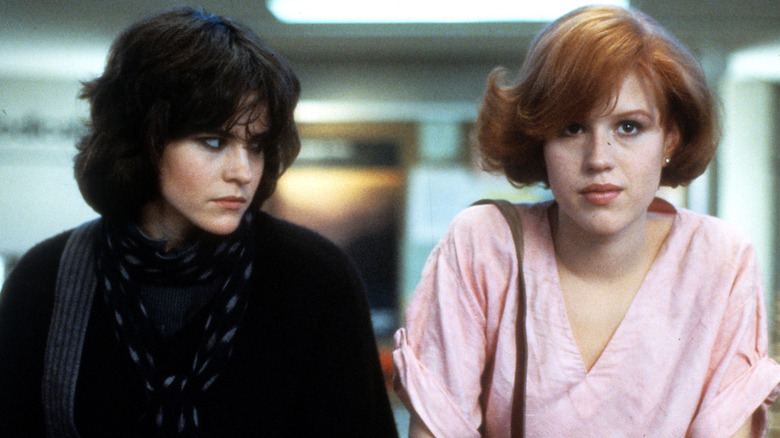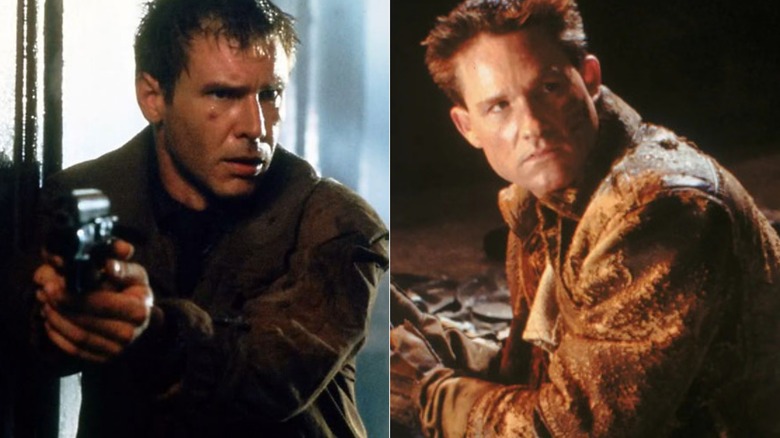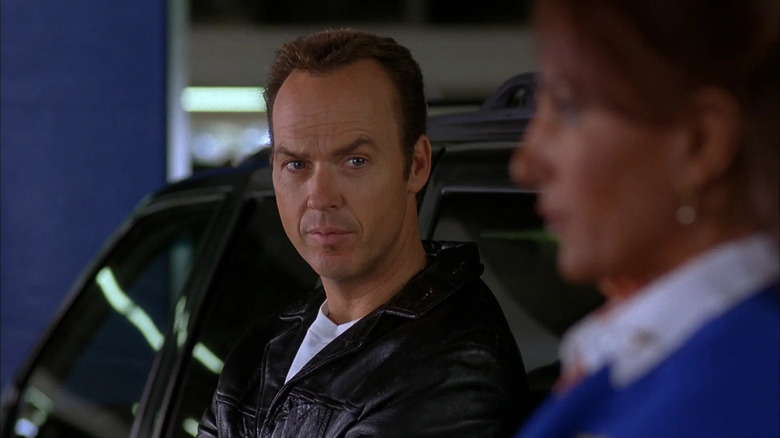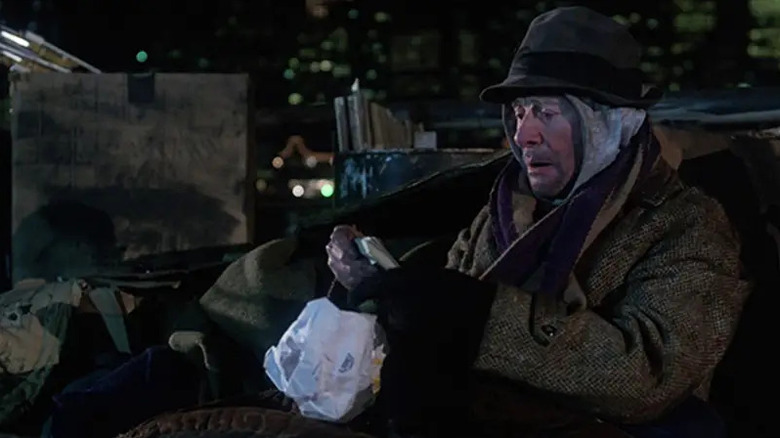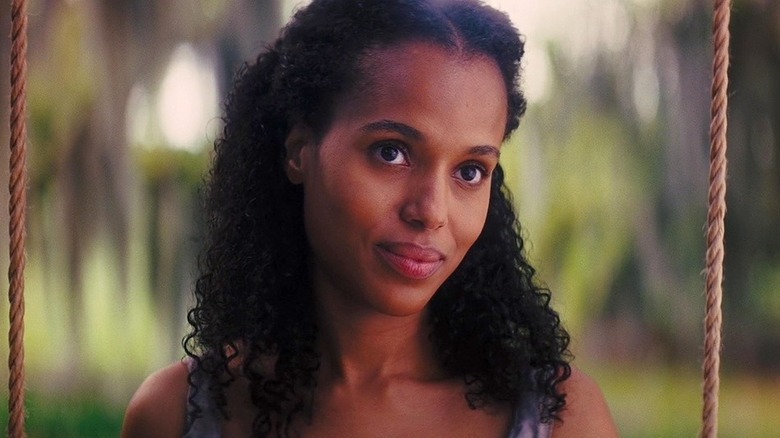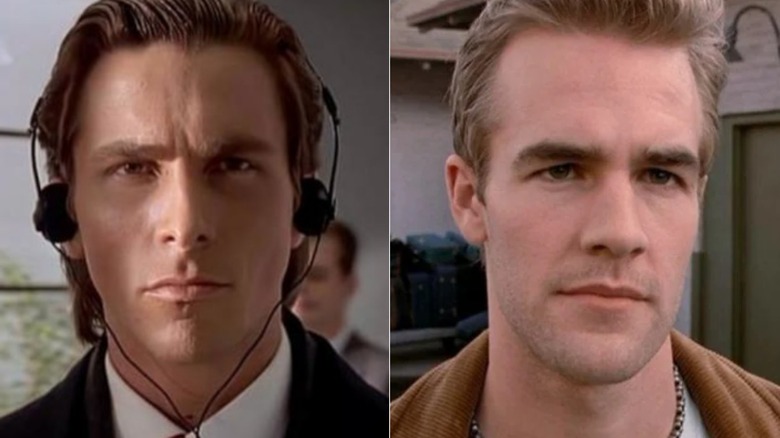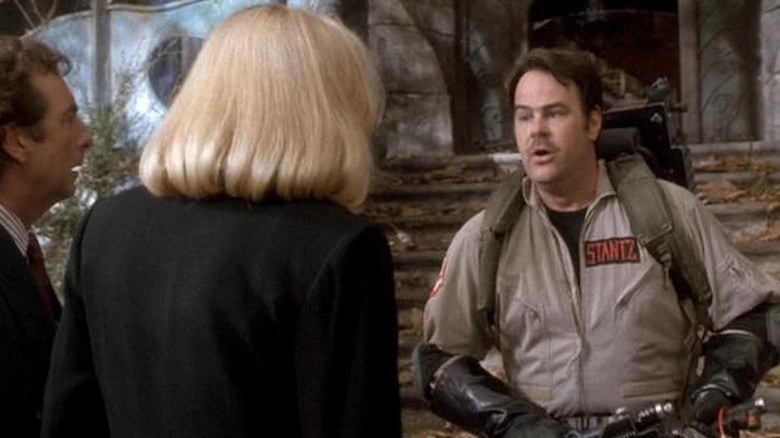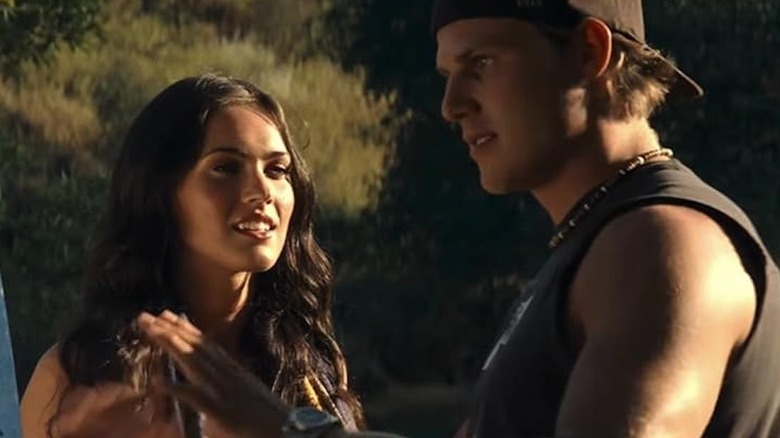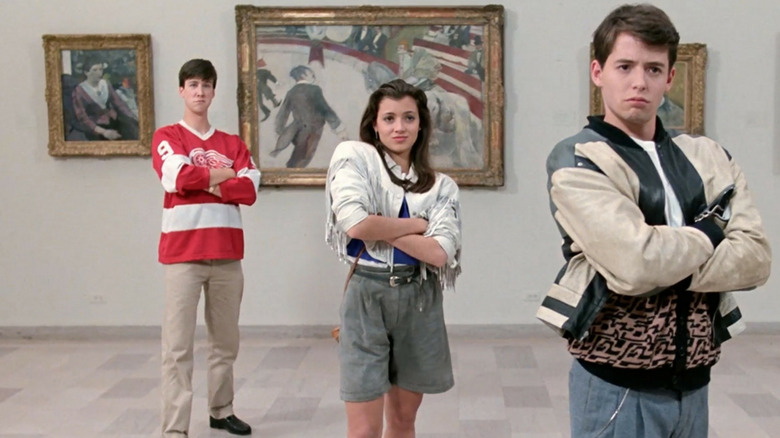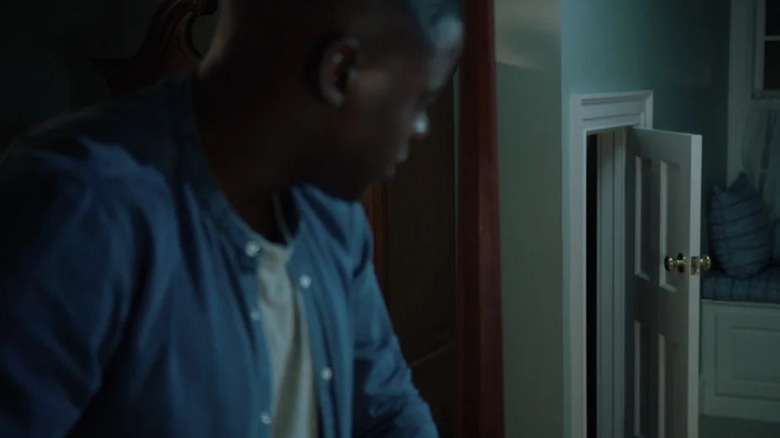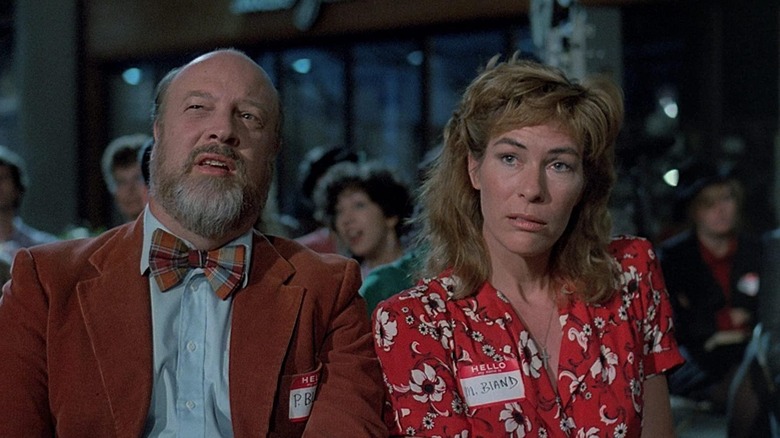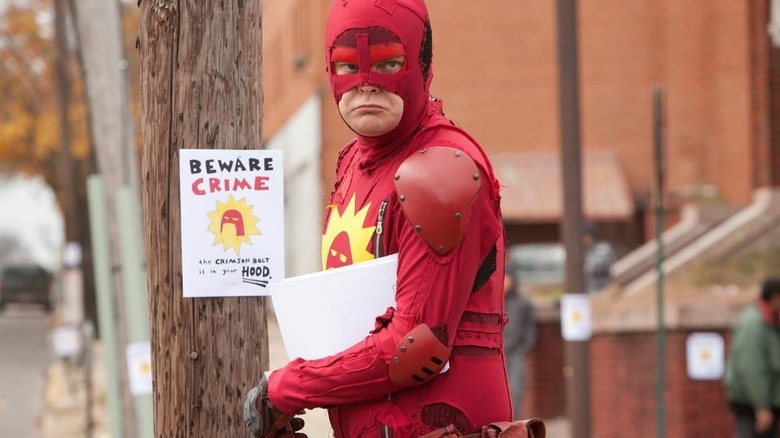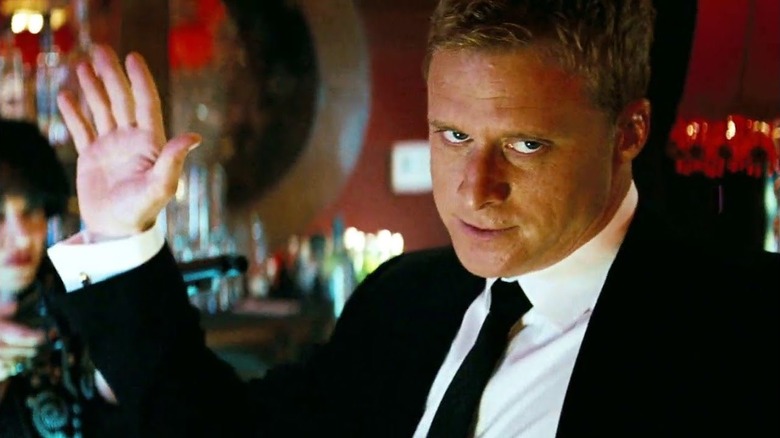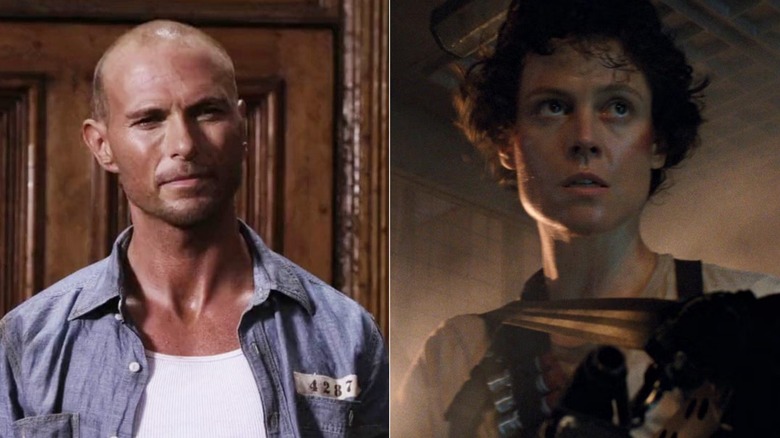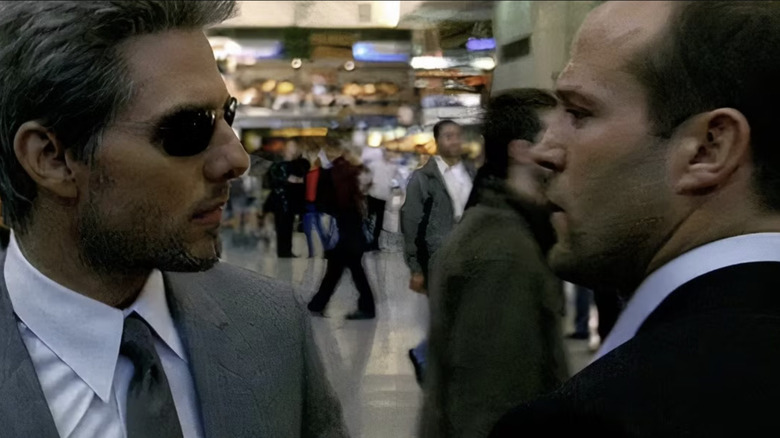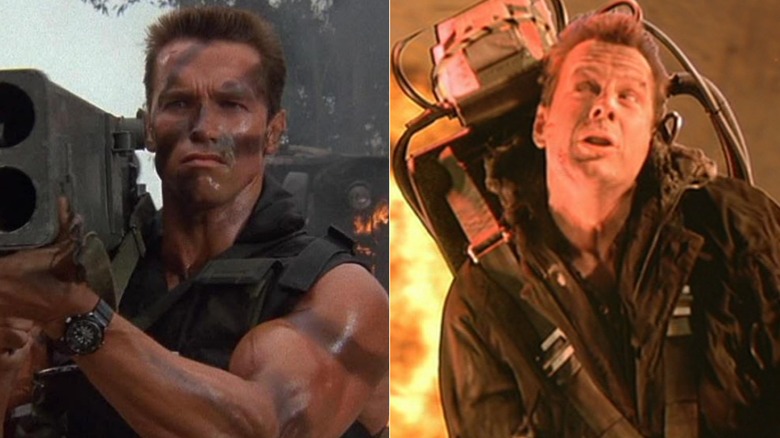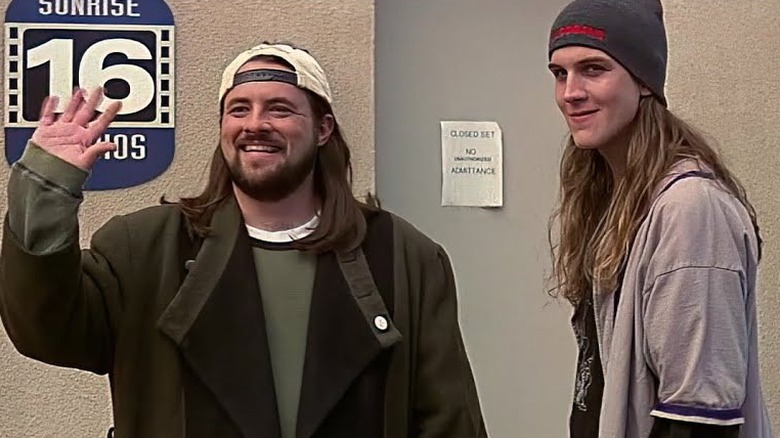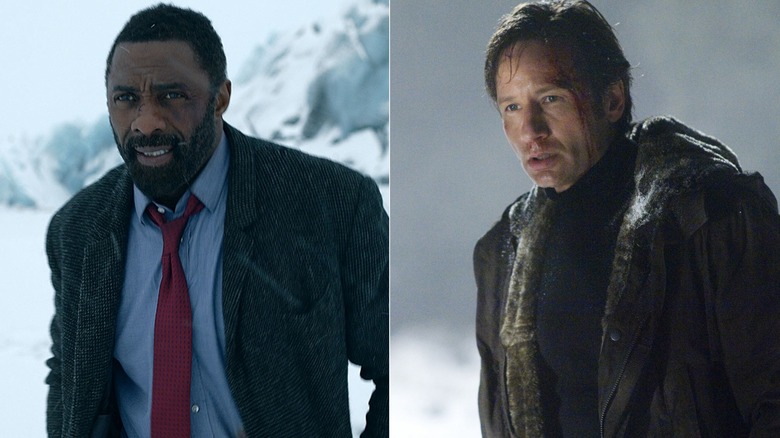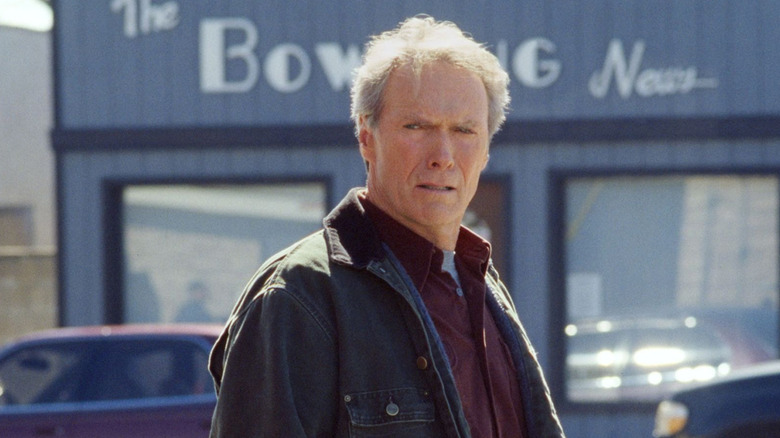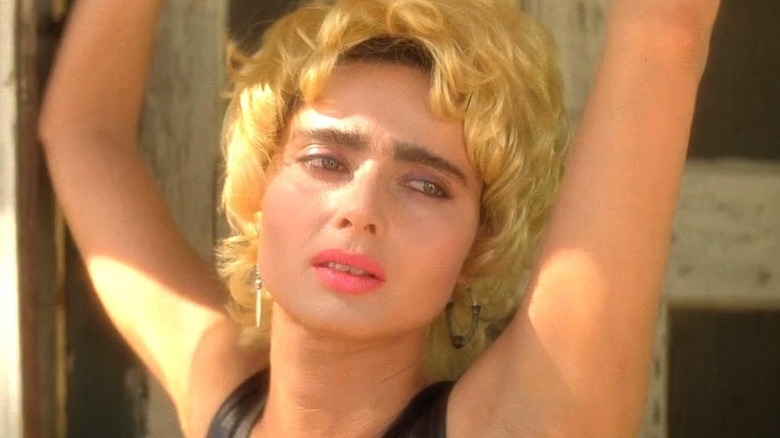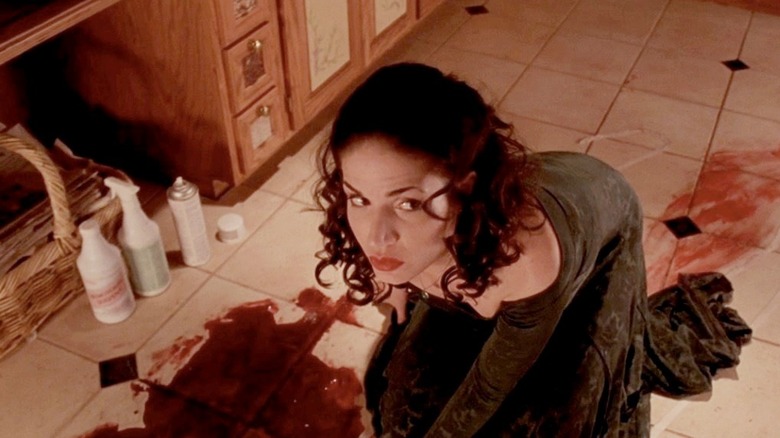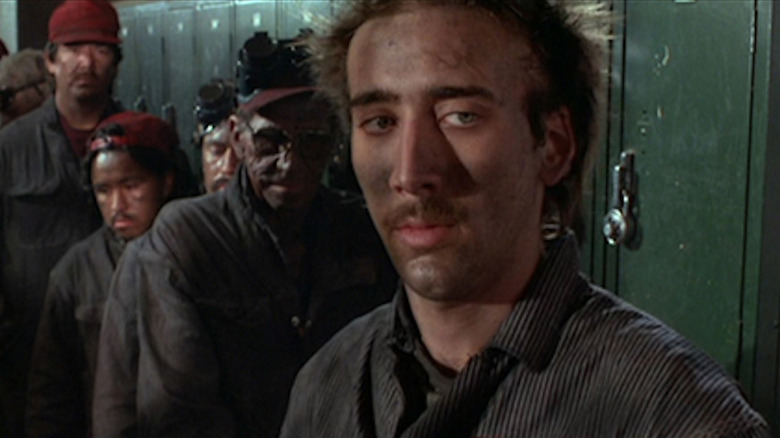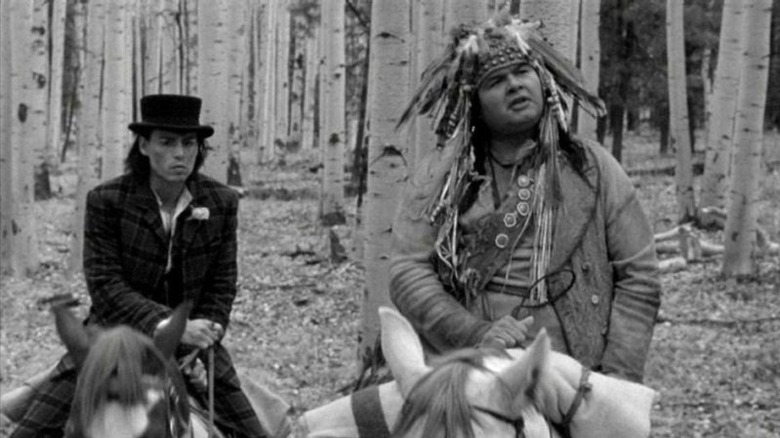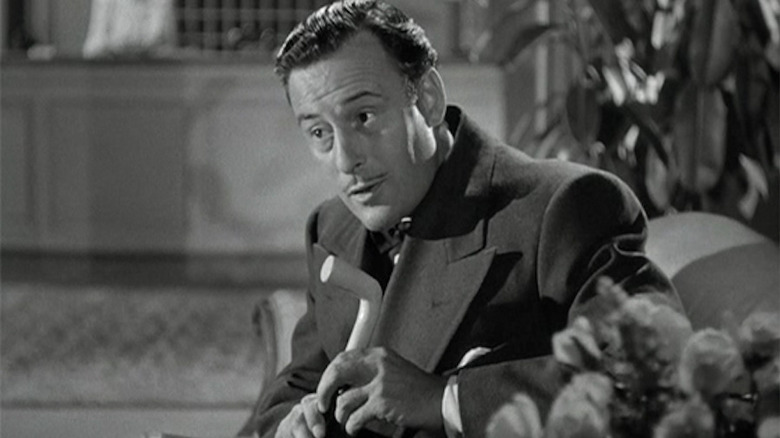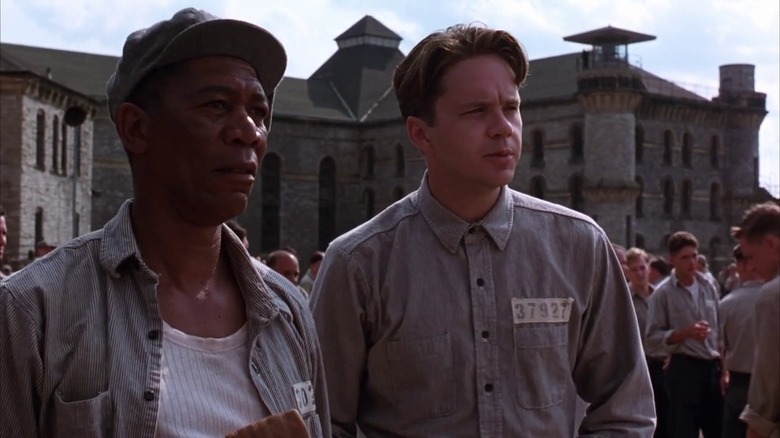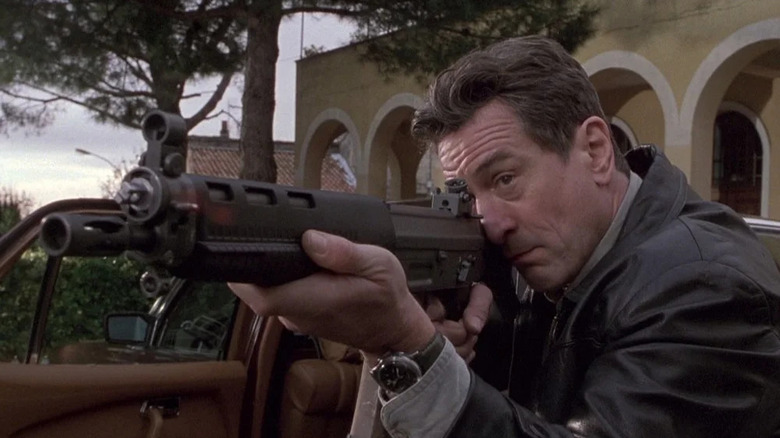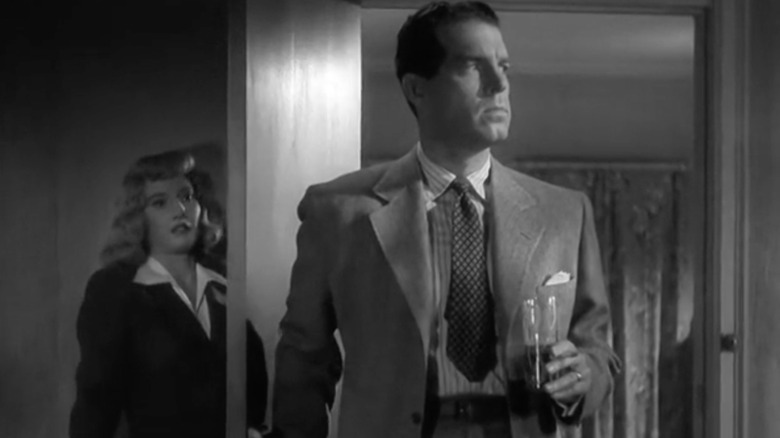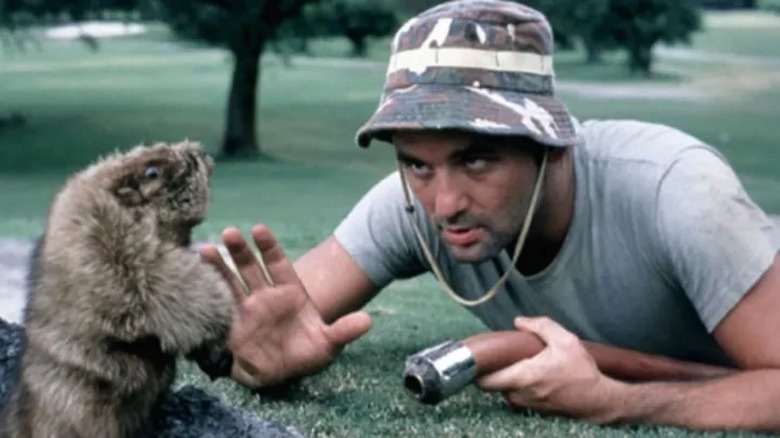Movies That You Never Knew Shared A Universe
Before "Iron Man" launched the Marvel Cinematic Universe, crossovers between otherwise unrelated movies were rare, even if those films shared a creator. Sure, the Universal Monsters had their little corner of horror cinema, but that was really it. Since 2008, of course, there's been a number of attempts at recreating Marvel's success, but most of those planned cinematic universes failed miserably. That doesn't mean, however, that there aren't other franchises and movies that are connected — and even share a universe — without most people realizing it.
Often this starts as an Easter egg, as when a Xenomorph skull was seen in the final moments of 1990's "Predator 2." This led to comic book crossovers and eventually a big-screen adventure, "Alien vs Predator," in 2004. But more often than not, these lesser-known connections fly under the radar, either because they don't get noticed at all or because audiences don't fully grasp the canonical implications.
What qualifies as a connected universe? Well, it has to be more than a joke — so we're not including crossovers that happened in pure parody films like "National Lampoon's Loaded Weapon 1," which featured cameos from "Star Trek" icon Scotty and Bruce Willis's John McClane. What we will consider, however, are crossovers that have the endorsement of their creators, writers, directors, and actors, even if studio rights make them not so above-board. Here are movies you probably didn't know took place in the same shared universe.
Blade Runner and Soldier
It should come as no surprise that two movies penned by the same screenwriter might exist in the same shared universe, even if one movie is an original work and the other based on a classic sci-fi story. This is the case with "Blade Runner" and "Soldier" — which is why so many people miss this one.
The 1982 sci-fi thriller "Blade Runner" is based on Philip K. Dick's short story, "Do Androids Dream of Electric Sheep?" and has long been considered one of the best sci-fi movies ever made. It's set in a dystopian future where androids, known as replicants, exist and can blend in with society. A replicant named Roy Batty (Rutger Hauer) gives a moving speech at the climax of the film where he references off-world locations — specifically, Tannhäuser Gate and the Shoulder of Orion.
Fast forward to 1998 and Kurt Russell's sci-fi action movie "Soldier," an original story from screenwriter David Webb Peoples — the same man who helped craft the script to "Blade Runner." In "Soldier," Russell's character, Sgt. Todd 3465, has been raised since birth by the military. We learn that he, like Batty, took part in battles at Tannhäuser Gate and the Shoulder of Orion. Meanwhile, one of the iconic "spinner" flying cars from "Blade Runner" appears in the background of one scene — cementing "Soldier" as a part of that film's universe.
Jackie Brown and Out of Sight
Written and directed by auteur filmmaker Quentin Tarantino, "Jackie Brown" was the first movie to follow the breakout success of "Pulp Fiction." And somewhat ironically, it's also the only movie in the director's filmography to be based on someone else's work. That work was the book "Rum Punch" by novelist Elmore Leonard, and thanks to Tarantino's love of blaxploitation, it stars '70s icon Pam Grier in the title role. A clever crime caper comedy, it's one of Tarantino's best, even if it isn't one of his biggest hits.
"Out of Sight" was released a year after "Jackie Brown" and was directed by Steven Soderbergh. It stars George Clooney as a bank robber being hunted by a female bounty hunter (Jennifer Lopez). It wasn't a huge hit either but did earn itself a TV spin-off, "Karen Sisco," starring Carla Gugino. But because "Out of Sight" wasn't as widely seen or fondly remembered as "Jackie Brown," many audiences forget that two characters from Tarantino's movie had small roles: Samuel L. Jackson and Michael Keaton, who appear in cameos. And it makes sense, because "Out of Sight" was also based on a novel by Elmore Leonard.
Interesting, "Karen Sisco" had its own crossover with another Elmore Leonard TV show: In 2012, Gugino reprised the title role in an episode of FX's "Justified."
Trading Places and Coming to America
Filmmakers rarely consider the canonical implications of a cameo, because it's usually just a joke. And that was probably what happened in 1988 when it occurred in the Eddie Murphy comedy, "Coming to America." The film saw Murphy playing African prince Akeem Joffer, who takes a trip to America to find a suitable bride.
In America, Joffer tries passing himself off as a lowly commoner to impress a woman named Lisa (Shari Headley). Dismayed when his assistant Semmi (Arsenio Hall) furnishes his apartment lavishly, Joffer donates all their money to two homeless men. At first glance, it might seem like a fun little gag, but the two homeless men are Mortimer Duke and his brother Randolph, played by Don Ameche and Ralph Bellamy — the two wealthy antagonists of Murphy's earlier movie, "Trading Places" — who wind up in poverty at the end of that film. The two return in "Coming 2 America," seen in paintings on an office wall, making this more than a mere one-off gag.
Some may dismiss this one because Eddie Murphy plays the hero in both films, nixing the notion that they could be in the same universe. But remember that Murphy already plays multiple roles in "Coming to America" — as Joffer, a barbershop owner, and of course Randy Watson, lead singer of Sexual Chocolate, one of the best fictional music groups in TV and movie history. And don't take our word for it: "Coming 2 America" director Craig Brewer insists there could still be a crossover movie.
Django Unchained and Shaft
You'd probably wonder how a movie set in the Wild West following the American Civil War and another about a crime-busting private detective in contemporary 1970s New York City could be related. Throw in the fact that the two films share no common links — not the same writer, director, or actor — and you are likely asking yourself what the heck we're talking about when we say that "Shaft" and "Django Unchained" exist in the same universe.
But remember Quentin Tarantino's love of blaxploitation? Well, the man just couldn't resist linking his work to one of the most famous blaxploitation movies ever made. In his 2012 film "Django Unchained," we meet the titular gunslinger, an escaped slave played by Jamie Foxx, who goes on a rampage to free his wife from her oppressors. That wife is Broomhilda, played by Kerry Washington, and while the film doesn't make any mention of the connection for obvious reasons ("Shaft" takes place 100 years later), it becomes obvious when you learn that her full name is Broomhilda von Shaft.
That was revealed later by Tarantino himself, who declared that the character is indeed intended to be an ancestor of Richard Roundtree's inscrutable John Shaft. Adding an extra layer of irony, of course, is that "Django" co-star Samuel L. Jackson also played John Shaft (the original's nephew) in two 21st century sequels.
American Psycho and Rules of Attraction (and maybe Less Than Zero)
A cult classic about the perils of toxic masculinity, 2000's "American Psycho" is a controversial adaptation of a banned book by Bret Easton Ellis. It's since become a seminal turn-of-the-century classic, while helping to make star Christian Bale a sought-after name in Hollywood. Bale plays Patrick Bateman, a smarmy banker on Wall Street obsessed with wealth, power, and self-image. Beyond his greedy exploits by day, however, Bateman also moonlights as a sociopathic serial killer.
By contrast, "Rules of Attraction" is a dark comedy starring James Van Der Beek of "Dawson's Creek" fame as a drug dealer caught up in a bizarre love triangle. But when you learn that Van Der Beek's character is named Sean Bateman, you begin to see the connection: The two lead characters are brothers, as "Rules of Attraction" is also based on a book by Bret Easton Ellis. In fact, there's even a deleted scene in "Rules" where Sean Bateman calls his older brother Patrick, looking for money — although Patrick is played here by Casper Van Dien and not Bale.
Interestingly, another Ellis book, "Less Than Zero," also takes place in the same fictional universe. But the 1987 movie version, starring Andrew McCarthy and Robert Downey Jr., omits the connections from the book.
Ghostbusters and Casper
Movie adaptations of classic comic books boomed in the 1990s, likely spurred by the incredible success of Tim Burton's 1989 smash hit "Batman." And it wasn't just superheroes, with titles like Harvey Comics' "Richie Rich" turned into feature-length adventures too. Another Harvey character, Casper the Friendly Ghost, got his own big screen outing in 1995. Mostly forgotten today, it stars Christina Ricci as Kat, a young, lonely teenage girl who befriends the ghost of a boy who died years earlier. That boy is Casper, whose specter remains — along with that of his two uncles — in the stately manor owned by a greedy socialite, Catherine Crittenden (Cathy Moriarty), who wants them gone.
While "Casper" never became a classic, the film was a big hit in theaters, earning nearly $300 million at the box office. But what many probably don't remember is the fact that one sequence firmly establishes it as taking place in the same world as another classic ghost-centered comedy. The scene in question comes when Cathy hires a series of paranormal experts to rid her home of the ghosts, with each of them failing miserably. One of those experts is Ray Stantz, Ghostbuster extraordinaire, played of course by Dan Aykroyd (and with a mustache this time). So is Casper really part of "Ghostbusters" canon? We think so.
Transformers and 2009's Friday the 13th
Few fans would ever think to connect an over-the-top sci-fi action schlockfest with the gritty reboot of one of the horror genre's most famous franchises. But look beneath the surface and you'll find some evidence that they are not so far removed from one another as you might expect. That's because "Transformers" director — and infamously bombastic filmmaker — Michael Bay is actually a producer on the 2009 remake of "Friday the 13th."
That reboot, starring Jared Padalecki, Danielle Panabaker, Aaron Yoo, and Amanda Righetti, retells the iconic story of Jason Voorhees, a mysterious hockey mask-wearing psycho who murders his victims with a machete. But how is that connected to a sprawling franchise about giant robots from outer space fighting a centuries-long war on Earth? It's down to the presence of actor Travis Van Winkle — who plays the same character in both movies, though that fact flew under most people's radar.
In the 2007 film "Transformers," Van Winkle plays obnoxious jock Trent, who is dating Megan Fox's Mikaela when the film begins. She quickly dumps him, but that's not the last we see of ol' Trent. Van Winkle turns up again two years later in "Friday the 13th," playing the exact same obnoxious jock, who this time cheats on his girlfriend. Given the complicated rights issues surrounding the latter franchise, however, don't expect this to ever lead to a crossover.
The John Hughes universe
Director John Hughes is responsible for a number of iconic '80s teen comedies, from "Pretty in Pink" and "Sixteen Candles" to "Weird Science." He's also the man behind such family classics as "Home Alone," "Planes, Trains, and Automobiles," and "Uncle Buck." But what many may not realize is that a lot of Hughes' movies all take place in the same fictional town of Shermer, Illinois — and a few of them are even set at the same school, Shermer High.
Shermer High School is called out by name in "Weird Science," "The Breakfast Club," and "Ferris Bueller's Day Off." The town itself is also the setting in nearly every other movie in Hughes' filmography. And this is no mere fan theory, as the director himself has confirmed that, yes, most of his movies all take place in the same universe.
"When I started making movies, I thought I would just invent a town where everything happened," Hughes told Comcast years later. Noting that everyone from all of his films hails from Shermer, Illinois, Hughes revealed that many of the characters in his films are neighbors. "Del Griffith from 'Planes, Trains & Automobiles' lives two doors down from John Bender [from 'The Breakfast Club']. Ferris Bueller knew Samantha Baker from 'Sixteen Candles.' For 15 years I've written my Shermer stories in prose, collecting its history."
Get Out and Being John Malkovich
In the mid-1990s, novice screenwriter Charlie Kaufman wrote a borderline abstract comedy-drama about people who live inside another man's head. It eventually found its way into the hands of another unproven talent — first-time director Spike Jonze — and the result was "Being John Malkovich," one of the weirdest, most ambitious, and downright risky studio films of the 20th century. In the movie, the head of John Malkovich — who plays himself — is linked to a doorway in an old apartment building that people can pass through and take control of his body.
Nearly 20 years later, comedian Jordan Peele made his own directorial debut with "Get Out," a psychological horror movie where a young man discovers that an enigmatic family is plotting to transfer their minds into the bodies of various Black people who they lure to their homestead. Right away, you can see how viewers of both films might take the two stories and link them together in a kind of fan-driven head-canon. That Catherine Keener stars in both films makes it even more intriguing.
The theory goes that Keener's character in "Being John Malkovich," Maxine, is the same character she plays in "Get Out," with a new name to hide her identity. But this became more than just fan fiction when Peele declared it official: "Get Out" is a sequel to "Being John Malkovich."
Chopping Mall and Eating Raoul
If you've never heard of either of these movies then you're in for quite a history lesson. Both are B-movies and indie classics of a sort, with "Chopping Mall" being a darling of '80s cult horror fans. That film, from 1986, follows a group of rowdy, sex-crazed teens who spend a night partying at a local mall after hours. They soon learn, however, that the mall is watched over by a new breed of security system with a screw loose, and before long they're picked off one by one by three out-of-control killer robots.
The 1982 film "Eating Raoul" is an indie black comedy featuring Ed Begley Jr., Buck Henry, and future "Star Trek: Voyager" star Robert Beltran. The real stars, though, are Paul Bartel and Mary Woronov as an uptight older married couple who get involved in the swinger scene as a means to fund their newest business venture by robbing and murdering the wealthy sex game participants.
The two films have little in common story-wise, though both are very darkly comedic. Yet that's not all that connects them, because in an early scene in "Chopping Mall," Bartel and Woronov appear as their "Eating Raoul" characters, who are present during the kill-bot's first demonstration. It's a left-field cameo that most viewers probably didn't even get, and it's even more perplexing to see Paul and Mary get the limelight in the scene, remarking about the strange robots to each other in a scene that feels like a dark in-joke.
Super and Brightburn
In just his second directorial effort, James Gunn crafted "Super," a gritty 2010 superhero comedy about an average man (Rainn Wilson) who has a religious awakening and decides to fight crime on the streets as a costumed vigilante called the Crimson Bolt. Darkly comedic in Gunn's usual style, "Super" was genre-shaking even if it wasn't a blockbuster hit, turning Gunn himself into a sought-after talent and laying the groundwork for "Guardians of the Galaxy" and the new DCU.
In 2017, Gunn produced another superhero movie, "Brightburn," that was less comedic and even darker, as the story followed a young boy from outer space with superpowers who doesn't use his abilities for good. It was a more twisted take on the Superman mythos, years before Gunn was enlisted to write and direct "Superman" for DC. But "Brightburn" was also part of its own shared cinematic universe, with a clear connection to "Super."
That connection comes during the closing credits, where news arrives of various super-powered incidents from around the globe. While one mentions an undersea monster and another references a super-powered witch, a photo of Rainn Wilson's "Super" character, the Crimson Bolt, is also shown. Sure, this was probably just a fun bit of world-building — some might even argue just an Easter egg — but it raises a lot of interesting possibilities when one considers a potential a "Brightburn" sequel (even if Gunn says it may never happen).
28 Days and Transformers: Dark of the Moon
We know that the first "Transformers" film is connected to the "Friday the 13th" remake by way of the smarmy jock Trent. But there's another, less talked about connection to the "Transformers" movies, and we're not talking about "G.I. Joe." We are, in fact, talking about the 2000 romantic comedy "28 Days," starring Sandra Bullock — not the most obvious movie to consider sharing a universe with "Transformers," especially given that it was released seven years before the Transformers made their live-action debut.
In that movie, Bullock plays an alcoholic forced to endure 28 days in rehab. There she meets a motley crew of fellow addicts, one of whom is played by Alan Tudyk of "Firefly" fame. His name is Dutch Gerhardt, and you'd never have guessed it at the time, but the same character turns up more than a decade later in "Transformers: Dark of the Moon" — at least, so says the actor.
"He's the same guy. Not only does he kind of seem like the same guy — he's the absolute same guy," Tudyk told AV Club in 2014. "He's changed his name. He went through rehab, and he got into the armed forces, he met up with Agent Simmons. He became a contract killer, he's overthrown governments in the third world. And then he got burned out and decided the only thing that he could do with his life was to devote himself to working with Agent Simmons, who's played by John Turturro."
If you or anyone you know needs help with addiction issues, help is available. Visit the Substance Abuse and Mental Health Services Administration website or contact SAMHSA's National Helpline at 1-800-662-HELP (4357).
Better Luck Tomorrow and The Fast and the Furious
Following "The Fast and the Furious" and "2 Fast 2 Furious," Universal Pictures opted in 2006 for a spin-off, "The Fast and the Furious: Tokyo Drift," directed by Justin Lin. Set in Japan, the film features actor Sung Kang as an old friend of Dominic Toretto named Han Lue. Savvy viewers, of course, recognized something that most of us didn't at the time: Han was not a new character, and he originated in an entirely different, unrelated movie from years earlier.
Justin Lin made his solo directorial debut in 2002 with the movie "Better Luck Tomorrow," which followed a group of discontented Asian-Americans who turn to criminal capers out of sheer boredom with their mundane lives in Los Angeles. Watch today and you'll see Sung Kang starring in the film as Han Lue, alongside Parry Shen, Jason Tobin, and John Cho.
A few years later, when Lin was tapped to direct the "Fast and the Furious" spin-off, he brought Sung Kang and the character of Han with him. Since then, Han has become a fan favorite, so much so that following his death in "Tokyo Drift," the film was retconned to take place after other movies in the series, allowing Kang to return — which he did four more times before it was revealed in "F9" that he wasn't dead at all.
Death Race and Alien
The "Alien" franchise has famously crossed over with the "Predator" franchise for two feature films, while both series are littered with other connections to each other — often through the existence of the Weyland-Yutani Corporation. This megolithic corporate entity funded the research into the "Alien" saga's Xenomorphs, and is even name-dropped in the 2025 film "Predator: Badlands."
That same reference, however, can be found in a more unlikely place: The 2010 action movie "Death Race 2" (the prequel to 2000's "Death Race"), starring Luke Goss. The "Death Race" films are set in a dystopian near-future where all prisons are privately owned and convicts are forced into deadly races for the amusement of the masses. In "Death Race 2," we learn that the Terminal Island Penitentiary, where the films are largely set, are funded and owned by — you guessed it — the Weyland Corporation.
Officially, it's unlikely the two franchises are truly connected to the point where they'd ever cross over on-screen — we're unlikely to see Goss' "Death Race" hero battling a Xenomorph, for example. But it's more than just a tip of the hat, as director Paul W.S. Anderson also directed the first "Alien vs. Predator" film, and it seems clear that, at least in his mind, the two worlds are connected.
Collateral and The Transporter
"Collateral" and "The Transporter" have a lot in common: Both are exciting action thrillers, both are headlined by a badass action star, and both feature a complicated criminal-for-hire as their protagonist. Both films also have some serious talent behind the camera, with "La Femme Nikita" director Luc Besson penning the script for "The Transporter" and "Heat" helmer Michael Mann sitting in the director's chair for 2004's "Collateral." So while many may not know about their connection, the fact that they take place in the same world makes a lot of sense.
In "Collateral," Tom Cruise plays Vincent, a shadowy hitman who ropes an unsuspecting cab driver into his latest mission. Two years earlier in "The Transporter" (and later in its two sequels), Jason Statham portrayed Frank, a one-man wrecking crew who makes a career out of being a high-level criminal courier. But even though "Collateral" is set in Los Angeles and the "The Transporter" takes place in Besson's native France, the two actually come face-to-face in a pivotal scene in "Collateral," as an unnamed courier played by Statham delivers a mysterious package to Cruise's Vincent.
Statham's role is uncredited, so it's easy to assume that this was just a coincidence, but "Transporter" director Louis Leterrier has acknowledged that they are the same character, even pondering at one point the possibility of Frank popping up in more movies from Michael Mann.
Commando and Die Hard 2 (and Predator)
Movies can share a universe via on-screen cameos, casual mentions of another franchise's characters, or even a background detail that links them together. In the case of "Commando" and "Die Hard," it's the presence of a single, fictional location: the Latin American nation Val Verde. In 1985's "Commando," Val Verde is the location of John Matrix's (Arnold Schwarzenegger) next mission, as he's hired by its villainous leader Arius to assassinate his enemies. But Matrix never makes it to Val Verde, as he betrays Arius and goes on a personal mission of his own.
Val Verde turns up again in, of all places, in 1990's "Die Hard 2: Die Harder." In the film, John McClane (Bruce Willis) goes up against the current dictator of Val Verde, who is being extradited to the U.S. to face trial. It might seem like an odd callback, but the presence of Val Verde in the "Die Hard" sequel is probably due to the fact that one of the men who wrote it also penned "Commando": screenwriter Steven E. de Souza.
What's strange is that Val Verde is only ever seen once on-screen, and it isn't in either movie: Val Verde is the primary setting for Schwarzenegger's 1987 classic, "Predator." De Souza wasn't even involved in that film, but nevertheless, three of that era's most iconic action movies all take place in the same universe.
Scream and the Viewaskew Universe
Although we aren't really considering fictional movie universes that originate in parody films, we're including "Scream" because — while it has been described as a satire of the horror genre — it's more of a black comedy with a sense of self-awareness. So here's a lesser-known crossover that you may have forgotten: Jay and Silent Bob's appearance in "Scream 3."
In that 2000 threequel, things get truly meta as the film visits the set of a movie-within-the-movie: "Stab 3," the third film in a trilogy based on the murders committed by the Ghostface killer from the first "Scream" entry. Set in Hollywood, "Scream 3" itself provides audiences with several surprise cameos, including "Star Wars" star Carrie Fisher and B-movie director Roger Corman both playing themselves. Not playing themselves, however, are Jason Mewes and Kevin Smith, who turn up on the backlot during filming as their "Clerks" characters Jay and Silent Bob.
It may seem like an odd cameo, but just a year later, the pair headlined their own movie, "Jay and Silent Bob Strike Back!" which takes the duo back to Hollywood. This time, they're looking for vengeance after a studio attempts to make a movie out of "Bluntman and Chronic," the in-universe comic book based on their likenesses.
Luther and The X-Files movies (and A Very Brady Sequel)
We may be cheating a little with this one, since both "Luther" and "The X-Files" are primarily TV properties, although both spun off into movies as well. But what makes the connection between these worlds noteworthy is how they are linked, because they are also two of the less-heralded entries in the Richard Belzer-verse.
Richard Belzer played Detective John Munch for decades on TV, most famously in the crime dramas "Homicide: Life on the Street" and "Law and Order: Special Victims Unit." He's also appeared in a number of other shows as well: He pops up in "The Wire" and "Arrested Development," and even makes animated and puppet appearances in "The Simpsons" and "Sesame Street," respectively.
Though he isn't mentioned in the film "Luther: The Fallen Sun," Munch does get name-dropped in an episode of the "Luther" series as a New York compatriot of Idris Elba's embattled British copper. But Belzer did play Munch on-screen in "The Unusual Suspects," a 1997 episode of "The X-Files" that takes Mulder (David Duchovny) and Scully (Gillian Anderson) to Baltimore, where Munch is interrogating a witness prior to his move to the Big Apple. The strangest connection of all is "A Very Brady Sequel," where, in an appearance played for laughs, Munch shows up to investigate Carol's (Shelley Long) first husband Roy (Tim Matheson).
Blood Work and The Lincoln Lawyer
Looper readers might know "The Lincoln Lawyer" best as the Netflix original series starring Manuel Garcia-Rulfo, but it was a movie first. Released in 2011, "The Lincoln Lawyer" stars Matthew McConaughey as a lawyer, Mickey Haller, who works out of the back of his Lincoln Town Car. Both the film and show are based on a series of books by author Michael Connelly, and, as many already know, the character of Mickey Haller is a relative of Harry Bosch of "Bosch" fame, connecting those two universes.
What fans might not realize, however, is that "The Lincoln Lawyer" is also connected to another movie based on a different Connelly novel: the 2002 thriller "Blood Work." Directed by and starring Clint Eastwood, the film follows Terry McCaleb, a grizzled FBI agent on the trail of a serial killer. But in the book on which the movie is based, a friend of McCaleb's recommends he consult a lawyer and drops the name Mickey Haller as a possibility. McCaleb claims to have heard of Haller, but the character never actually shows up in the story. Even more curious? The first "Lincoln Lawyer" novel was still years away, meaning readers didn't even understand the importance of the reference.
Wild at Heart and Dance with the Devil
There are quite a few movies, like "Out of Sight" and "Jackie Brown," that are connected by a single, minor character but are easy to overlook as sharing the same universe because said character only plays a small role. But it's a bit different in the case of "Wild at Heart" and "Dance with the Devil," because that minor character wound up getting their own film. The reason why audiences might not have noticed, though, is that the character swaps actors.
Based on a book by Barry Gifford, "Wild at Heart" is a 1990 David Lynch classic that tells the story of Sailor and Lula (Nic Cage and Laura Dern), a criminal couple on the run. During their adventures, they bump into an old friend of Sailor's named Perdita Durango, played by Isabella Rossellini. In 1997, "Dance with the Devil," directed by Joe Smith, arrived in theaters — but outside of the U.S. it was known by another title: "Perdita Durango."
"Dance with the Devil" is based on another Gifford book, but rather than Rossellini returning as the character, it stars Rosie Perez as Durango, with a young Javier Bardem beside her. A joint U.S./Mexican co-production, it didn't get much attention at the time, and, outside of those familiar with the books, few probably realized it was connected to "Wild at Heart."
The Principal and Abraxas: Guardian of the Universe
You've probably never heard of "The Principal," and you may only know "Abraxas: Guardian of the Universe" as an awful sci-fi B-movie starring former WWF wrestler and eventual Minnesota governor Jesse Ventura. One is a drama about a down-on-his-luck teacher (Jim Belushi) who is reassigned to a high school in a crime-ridden neighborhood. The other is a low-budget, sci-fi action movie about an alien space cop who comes to Earth to stop a fellow alien who's conceived a part-human child who could destroy all life in the universe.
Yet, as strange as it may sound, "The Principal" and "Abraxas: Guardian of the Universe" take place in the same shared universe — and it's not a case of a humorous Easter egg, a blink-and-miss-it cameo, or a shared company logo. Belushi, who stars in "The Principal" as Rick Latimer, reprises his role in "Abraxas," returning to play the principal of the school that the half-alien child attends. It's a head-scratching appearance, but, according to legend, Belushi agreed to do it because he was dating Marjorie Bransfield at the time, who played Sonia, the child's mother.
From Dusk Till Dawn and Curdled
"From Dusk till Dawn" may not have been directed by Quentin Tarantino, but he did write the script and also co-starred in the film. The movie chronicles the exploits of dangerous criminal brothers, Seth and Richie Gecko (George Clooney and Tarantino), but it would be criminal not to mention that the film is actually a violent, visceral vampire flick, and it remains one of Clooney's best movies three decades later.
By contrast, "Curdled" tells the story of Gabriela (Angela Jones), a woman obsessed with the urban legend that a severed head can still speak after being detached from its body; she wants to just know how true this is, even if she has to do it herself. But as disturbing (and darkly comedic) as the film and its characters are, it's decidedly not a vampire movie, nor is there anything supernatural about it. And yet, it's connected to "From Dusk Till Dawn" thanks to a single scene where Kelly Preston reprises her role as a newscaster giving a report on a pair of missing criminal brothers, Seth and Richie Gecko. That Tarantino was a producer on "Curdled" ties it all together with a nice little bow.
The Hudsucker Proxy and Raising Arizona
The Coen Brothers are among the most eccentric filmmakers Hollywood has ever seen, having written and directed some of the most unique films of the last 40 years. Classics like "The Big Lebowski" and "Fargo" mix caper crime fiction with black comedy and oddball characters in ways that make them hard to classify by genre. "The Hudsucker Proxy" and "Raising Arizona" are two of their more off-the-wall movies, and yet audiences may never have realized they exist within the same shared universe.
A movie that took years to understand, 1994's "The Hudsucker Proxy" centers on a bumbling factory worker who, through a complicated scheme by his corporate overlords, winds up in charge of Hudsucker Industries, a multinational conglomerate. "Raising Arizona" is a crime comedy from 1987 starring Nicolas Cage and Holly Hunter as a miscreant couple who steal a baby when they discover they can't have children. But eagle-eyed viewers watching "Arizona" on home video or television in the 1990s may have noticed a nod to "Hudsucker Proxy" — despite having been released seven years earlier.
In "Raising Arizona," Nicolas Cage's character, H.I. McDunnough, works a day job at a factory. Not just any factory, though: it's owned by none other than Hudsucker Industries. That's right, an Easter egg for a movie that wasn't made until nearly a decade later.
Black Swan and Requieum for a Dream
"Requiem for a Dream" was long considered director Darren Aronofsky's masterpiece, but just a decade later, his mind-bending drama, "Black Swan," netted him an Academy Award nomination, and star Natalie Portman took home a trophy for her performance as its star. Beyond their critical acclaim, the two dramas have something in common, as they both center on women who slowly lose their grip on reality — though for wildly different reasons. And yet, a careful inspection reveals they are connected on an even deeper level.
That connection comes in the form of a minor character known as Uncle Hank (Stanley B. Herman). In "Requiem for a Dream," fans will recall that Uncle Hank is the man who chants a certain X-rated phrase while the film's two main characters are engaged in a debaucherous activity. Suffice it to say, it's a pivotal and disturbing moment that, for many, defines the dark nature of the film.
10 years after "Requiem for a Dream" shocked audiences, Uncle Hank returned in "Black Swan," this time as a commuter on a train who is shown directing sexually suggestive sounds and gestures towards Nina. It's another unsettling moment that also reveals that the two films take place in the same shared universe.
Dead Man and Ghost Dog
Ever seen Jim Jarmusch's films? If not, you're missing out. Though they're all great, one of his best is 1995's "Dead Man," a 19th-century period piece about William Blake (Johnny Depp), a wanted killer on the run. During a violent encounter, Blake is shot and left for dead, but gets help from a mysterious Native American man (Gary Farmer) who was raised by wolves and is known only as Nobody. It's a powerful film about one man's spiritual journey towards redemption ... and it's not the last time we'd see Nobody, either.
His next appearance would come four years later in Jarmusch's next film, "Ghost Dog: The Way of the Samurai." This one, however, isn't set in the 19th century but, rather, in contemporary times (in this case, the year 1999). The film tells the story of a hitman (Forest Whitaker), who possesses samurai-like skills that he uses to make himself the perfect killer. And though he isn't decked out in any Native American garb, actor Gary Farmer reprises his role as Nobody, even uttering an identical piece of dialogue from his turn in "Dead Man" that makes it clear he's playing the very same character.
Tangled and Frozen
"Frozen" and "Tangled," released three years apart and both about a trapped princess, are two of the biggest animated Disney movies of the 2010s. In "Tangled," Rapunzel is physically imprisoned in a tower, and in "Frozen," it's Anna's kingdom that's been trapped in an eternal winter. But a single Easter egg in the latter reveals that the two films may have more in common than their lead princess's dilemmas and, in fact, take place in the same shared universe.
It happens during Elsa's coronation, where, if you look closely, you might spot Rapunzel (after her hair has been chopped off) and Flynn Rider in attendance. The connection between the two films, however, could go even deeper, according to popular fan theories. As many have suggested, the trip that Anna and Elsa's parents took in "Frozen" — three years before the events of the film — could have been to attend the royal wedding of Rapunzel and Flynn. Hitting a storm, they never made it, and, years later, Rapunzel and Flynn attend their daughter's coronation. Of course, there are also theories that Disney's "Tarzan" and Little Mermaid" are part of the "Frozen" universe...
The Cat People and The Seventh Victim
Among the oldest shared universes — outside of the Universal Monsters — is a world that ties together a pair of movies from the early 1940s, "The Cat People" and "The Seventh Victim." Both are supernatural horror movies, both revolve around women who are at the center of a curse of some sort, and both were produced by Val Lawton and written by DeWitt Bodeen.
These days, fans of the films often refer to 1943's "The Seventh Victim" as a prequel to "The Cat People," which was released a year earlier. That's owed to the presence of Dr. Louis Judd (Tom Conway), a psychiatrist who plays a key role in both movies. In "The Cat People," he's trying to help a woman who believes she'll turn into a cat when she's aroused, and in "The Seventh Victim," he's counseling a woman who is in a Satanic cult. Of course, the reason why "The Seventh Victim" is considered a prequel is because, in Judd's first appearance in "The Cat People," he's violently murdered in the film's final act.
Most Stephen King movies
We've already discussed how movies based on books from the same author can be connected, but with legendary master of horror Stephen King, it goes even further. As most fans of his work know by now, a whole host of his novels take place in the same fictional universe, and that extends into their movie adaptations. In fact, there are so many connections between King-based films that we could have an entire article on just this alone. But for the sake of brevity, here, we'll just touch on a few of the more notable connections.
A common pick for people's favorite movie of all time, "The Shawshank Redemption" is connected to most of King's work, as the Shawshank Prison is often mentioned. Reddit user u/pastoston compiled a list of references to Shawshank in the book versions of "Needful Things," "IT," and "Dolores Claiborne." It was even referenced in "Dreamcatcher," which became a movie starring Morgan Freeman, who famously co-starred in "The Shawshank Redemption." "Shawshank's" main character, Andy Dufresne, is also mentioned in the book version of the Bryan Singer film "Apt Pupil," while "Shawshank" itself features a sly nod to "The Dark Tower."
The Bourne Identity and Ronin
Matt Damon became a superstar thanks to "The Bourne Identity," a 2002 action-thriller whose shaky cam action sequences and fight scenes that felt visceral and raw changed the genre forever. "Ronin," the 1998 film starring Robert De Niro as a mercenary hired to steal a mysterious briefcase, didn't have quite the same impact. But while the latter is an original story, not based on a book, the writers threw in a reference to a character from the novel version of "The Bourne Identity."
That character is Chernak, a wheelchair-bound mercenary broker who puts hired guns in touch with clients who need their services. Though he doesn't show up on camera, he is referenced by De Niro's character, Sam. And while Chernak doesn't appear in Matt Damon's "Bourne Identity," he does appear in the previous version of the film starring Richard Chamberlain, which aired on television in 1988, where he was played by the late Bill Wallis.
Double Indemnity and Ace in the Hole
The idea of a shared universe may be a more modern conceit, and most of the entries on this list demonstrate that even minor, background crossovers are a relatively recent invention of sorts. Yet, go back to the mid-1900s and you'll find at least two unrelated movies that were linked together by a single character to form a cinematic universe: "Double Indemnity" and "Ace in the Hole."
Ranked among the most suspenseful movies of all time, "Double Indemnity" focuses on a salesman working for Pacific All-Risk Insurance who falls in love with a woman who is plotting the murder of her husband. "Ace in the Hole" arrived six years later and revolves around a downtrodden reporter looking to rejuvenate his career with a sensational story of a man trapped in a well. The first thing they have in common is that both were written and directed by renowned filmmaker Billy Wilder. The second thing is that Wilder connected "Ace in the Hole" to his previous film through the character of Al Federber (Frank Cady), who is a salesman at Pacific All-Risk Insurance.
Ghostbusters and Caddyshack
We've already discussed how, thanks to a cameo that was merely a gag, "Ghostbusters" and "Casper" exist in the same universe. Well, you can add "Caddyshack" to that universe, too. The 1980 comedy was directed by Harold Ramis and co-starred Bill Murray, so it already has half of the "Ghostbusters" cast among its crew, and it's in "Ghosbusters" that we get an apparent crossover between the movies ... but only in a deleted scene.
That scene comes when Louis Tully (Rick Moranis) is running for his life and bumps into Murray and Dan Aykroyd, shoving them aside in panic. But in this scene, Murray and Aykroyd aren't playing Peter Venkman and Ray Stantz, but a pair of unnamed vagrants. Fans who are familiar with the scene have long noted the striking similarity between the bum played by Murray and Carl Spackler, the drunken groundskeeper he played in "Caddyshack."
Sure, one might chalk this up to coincidence, but it doesn't make much sense to give Murray a second role in the film ... unless, of course, it's intended as a nod to "Caddyshack." Especially since, at the time, "Caddyshack" was arguably Murray's most famous movie, and Spackler his most well-known work outside of "Saturday Night Live."
